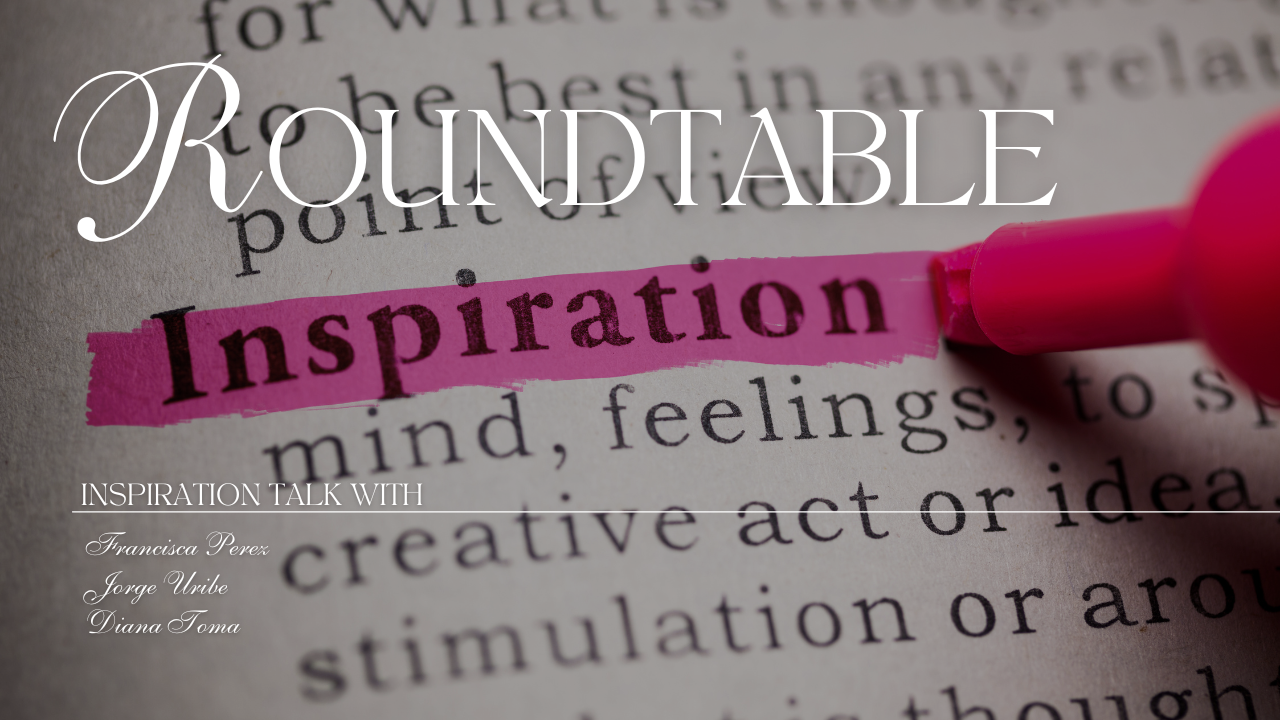
Roundtables in the Circle Community
Dec 18, 2022Inspirational talks
A blog on growth, inspiration and floral design with EMC Coaches
The EMC coaches taking part in this inaugural round table discussion are Diana Toma from Romania but now living in Belgium; Jorge Uribe from Colombia, now living in the USA; and Francisca Pérez Aguirre who lives in the centre of Santiago, Chile. Diana started the discussion by explaining that the Round Table Discussions would be hosted on the EMC Circle Community platform, involving different EMC coaches. The idea would be to keep them informal, friendly and that the participants would welcome questions both during the discussions and also after the live discussions have ended as people would be able to watch the video in their own time. She then invited Jorge to talk about his very attractive and unusual bridal bouquet, with which he had just won the "Ian Prosser" Bridal Bouquet competition at the Florida State Convention.
blog by Sara Marie Andrews EMC
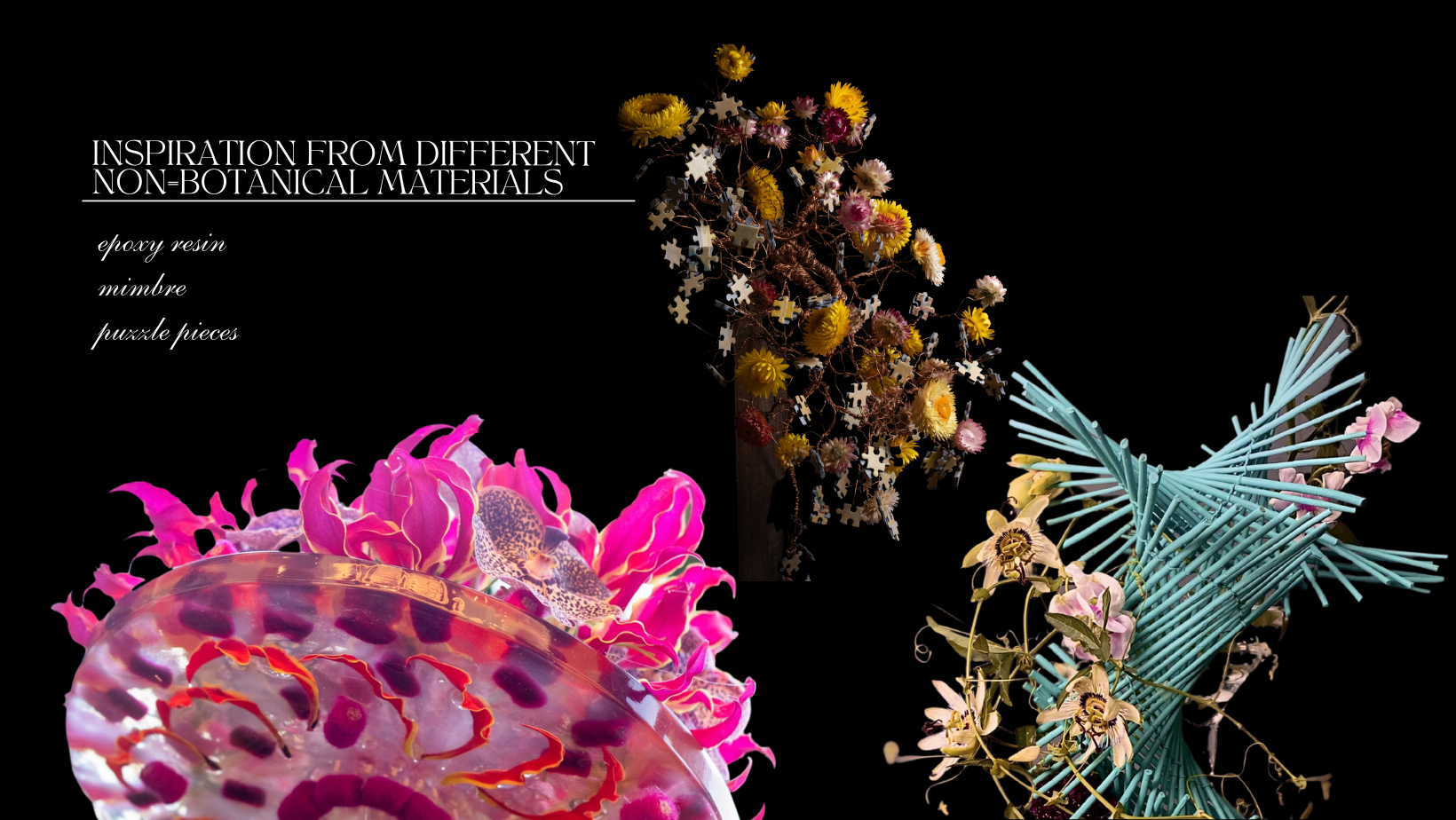
Jorge started by talking about what he understood inspiration to be…. “Something that influences you to do something creative, and creativity is using our imagination to produce artistic work”. He is always trying to inspire himself by using different materials in his work. When he heard about the competition, he really wanted to do something different. He decided that he really wanted to work with resin, using chemicals that are very strong and necessitate careful handling, including the use of protective gloves. Using resin for the first time was a big learning curve with some experimentation. The first time that he placed Gloriosa petals in the resin, the chemicals were so strong that, within five minutes, it had burnt the petals away! It was very interesting to see the first sample which he had kept to demonstrate how strong the chemicals are and how careful you have to be.
When you are using resin, it is necessary to use a mould in which the liquid sets, and it needs to be made of silicon, as it is flexible. Jorge purchased a large silicon cake ‘tin’, which he used as the mould for his first attempt. However, it was not suitable as it had a large diameter and was quite shallow, but he wanted to see how it would work. To get the effect that he wanted, he needed something that would remain flat. As you pour the resin into the chosen mould, you add any botanicals and non-botanicals, but they need to stay where you place them, and if you touch them before the resin hardens, they move around. All the pollen bled into the resin, which turned the resin yellow too, which he did not want to happen. Diana said it looked really cool but would probably mess up his concept with the colour. What he did find was that if he removed the hardening resin from the mould before it was 100% dry, you can actually manipulate it into a different form, such as curved, which he did not want for this design, but he might try in the future. His real inspiration was to create something very strong but that also had a real transparency that you would be able to see the flowers, giving you a magical view of the flowers, with the light coming through at different angles, and you can see the glow which makes the colours dance and pop. Colour creates the sensations in your eyes.

As he wanted to have something dense that you could still actually see through, where the whole effect was truly magical, so he felt that he needed a bigger mould. However, when he started researching, he found that bigger silicon moulds were very expensive, so he decided to make his own. He bought another baking pan, plus a slightly smaller one, and a silicon mix. He used the bigger one as the mould, adding the silicon produced from mixing equal amounts of chemicals from two separate tins, then placing the other pan on top, so that the silicon was like the filling in a sandwich, until it set. Once set, the silicon mould was removed from the baking tins. He then mixed up more resin, which is a much more complicated process. It has to be stirred very carefully and precisely for five minutes, enabling the chemicals to react together precisely. Diana suggested the mixing could be done with a specialised bit fitted into an electric drill, which ensures that it is all mixed fully within that five-minute time span. It was at this point that Jorge poured it into his homemade mould and went off to the symposium.
He had very little time on his return to complete the bouquet. To overcome the problem with the Gloriosa petals discolouring, he bought a very realistic long, silk, stem of Gloriosa. Even then, having used such strong chemicals, he found that the colour began to change. The red petals took on a more orange hue, but not enough to look really wrong. To form the actual bouquet, he used a bouquet holder, having removed the foam. He is very keen on giving step-by-step descriptions of what he does, because when he is doing something different, he wants others to be able to understand and follow the process, so that they can try it themselves. He feels that it is important to share everything that we do, as that is what coaches and teachers should do.
He also incorporated some of the wool from Lehner that they had used on their trip to Austria, because it was exactly the colour of the Gloriosa but gave a different texture. He actually managed to incorporate some of it into the resin along with the silk Gloriosa, something that has to be done very quickly as they will compact and will also move around within the resin, and you need to keep them in the places where you want them to be. Showing the back of the bouquet, incorporating the bouquet holder, you could see how the holder had merged into the resin to become one entity. He has also now found that, using a very fine sandpaper, he can sand the resin base, clean it, and then apply another thin layer of resin, so that it can be reused. Diana added that you can also wax and polish the resin if you want a different effect.
He drilled little holes into the resin, wired all the flowers, wrapped the stems in yarn before inserting them into the holes and fixing with glue. Even the Gloriosa were wired, taped, and wound with very fine yarn before being incorporated into the design. He really wanted the mechanics to show and be part of the finished design, aided by the amount of transparency, where everything could be seen. Diana appreciated this in his design, saying that it was great for people to actually see what the designer had actually done. The Ian Prosser Bridal Bouquet competition allows you to take the bouquet already completed, which allows more people involved in bridal work to bring along bouquets that they have made prior to the event. Jorge was already involved in the main competition at the convention but felt that he could take part in the bouquet competition too, as it could be prepared beforehand. He felt that it was also the right competition to show something very different, with which Diana agreed, saying that he had done a super-cool job.
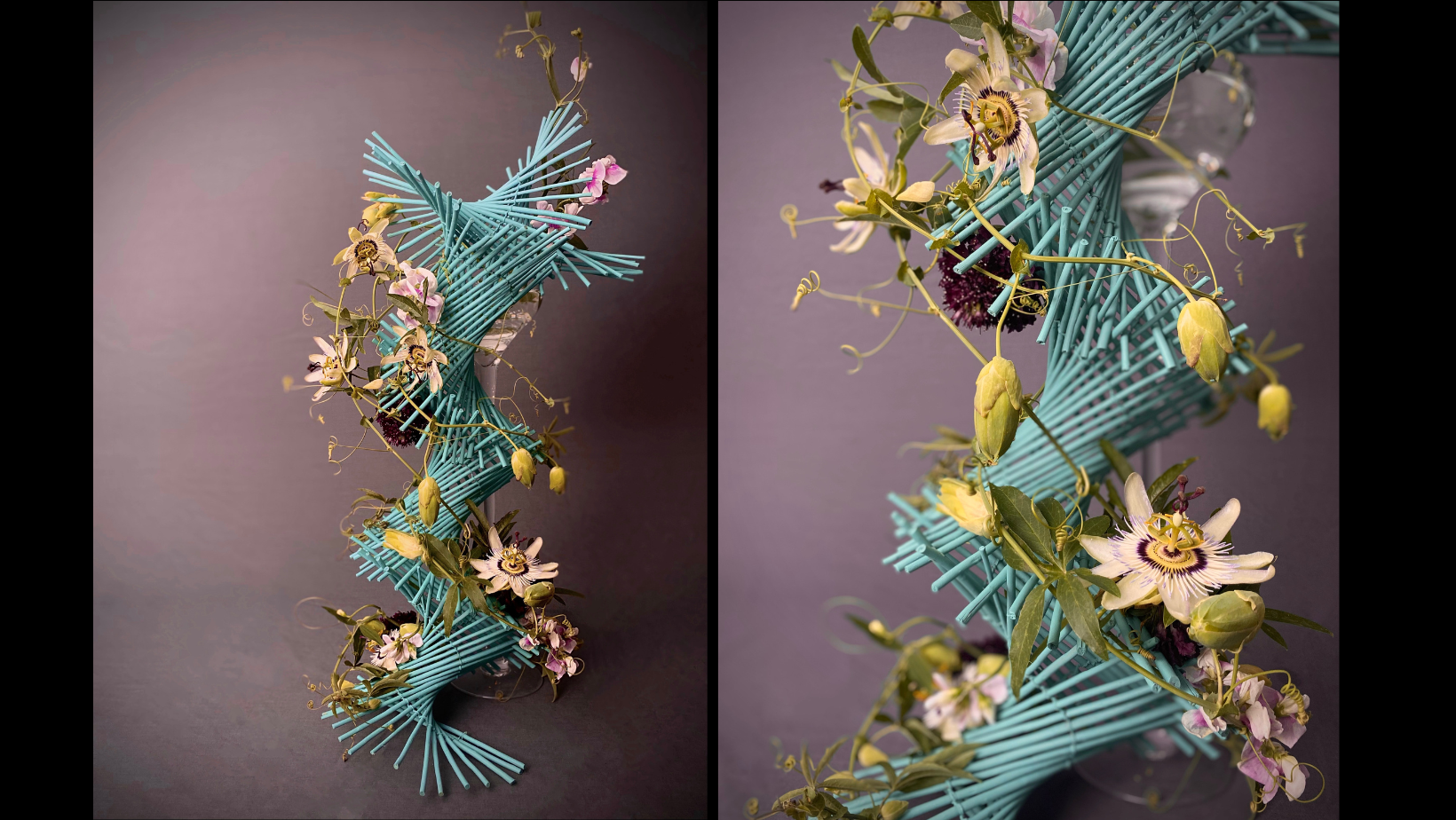
Moving on to Francisca’s design, which was actually featured in the Trend Fanzine, which can be found in the Circle Community. She has used really cool, unexpected botanical materials in such a striking way and Diana hoped that she would be able to explain more about the design, and how she had come up with this ultra-cool way of working with inspirational techniques, based on the use of the bamboo sticks. Fran quickly explained that they were not bamboo but mimbre sticks, which are used for a vast range of purposes by the people of Chile, including making furniture. Fran explained that you cannot get them in Santiago, and she had driven for three hours to the city of Chimbarango, where she could buy them. They grow there and the whole of the city is built on the work that can be done by the growing, harvesting and usage of mimbre (Salix viminalis). She asked around as to where she could buy some of the sticks, and actually ended up purchasing some of the sticks bound together tatami fashion. When she got it home, she started moving it around, not wanting to just use it in the flat mat dimension. By experimenting, she found that she could hold it up, move it, and twist it, producing very interesting and dynamic shapes. Jorge found that the movement was very interesting, turning it into something reminding him strongly of DNA. Fran found that being coloured blue and, with the movement, it interacted very well with the Passiflora.
Diana asked her what had really inspired her about the material. Fran replied, saying that it was very difficult to find a range of materials in Chile, similar to those available in Europe. They do not have the same array of sundries wholesalers, so she actually found the mimbre woven with the tatami technique very inspirational. She said that it was also possible to find thinner sticks too and also smaller sticks, as she looked around the range of mimbre that she could purchase. It is a small city, but everything there revolves around how mimbre can be used. Jorge explained that the sticks can also be split and bent, so can be made into a wide range of structures, and so much can be made by weaving for use in a wide range of crafts. He has also seen it split into a string and criss-crossed. A really cool, sustainable mechanic and material. As Diana added, everything is handmade with no machines used, such imagination and inspiration does not come easily compared with modern machinery and furniture. Jorge said that it shows all the original, traditional methods and anything produced in this way is now truly appreciated in the States for its craftsmanship. The new generations are appreciating what has happened, and that it is now considered cool to purchase items that are ‘handmade’. Diana was delighted to know that people appreciate handmade craftsmanship and see it as a super valuable inspiration but realise that it cannot compete with the big commercial furniture industry today. That isn’t possible, but it is really cool that a florist travels all the way from Santiago to use the material somewhere else, in a different way that they are not used to, producing a really cool design.
The final design in this section was the one that Diana had completed. She began by saying that it seemed very odd to introduce her own design as she was hosting the discussion, but Fran encouraged her to talk about it as she loved the shape and the transparency and wanted to learn more about it.

Diana started by saying that she had started the design about two years ago. With two small children around, it is hard not to lose pieces of jigsaw puzzles. The one that has been used in this design is one with a thousand very small pieces. She had to make a decision as to whether to throw it away or not but, as it was a self-portrait of Vincent van Gogh, she just felt that couldn’t throw such an important painter away into the garbage! She decided that she would do something with the pieces, and they really dictated the colour palette. She had the pieces there, the colours were there, and she felt that if they were good enough for Vincent van Gogh, she should work with them too.
It took a long time to complete the structure and a long time to wire all the dried flowers and the puzzle pieces in order to have enough for the design. When it was finished, she put pictures of it on Facebook and somebody contacted her to purchase it, but this was not the reason that she had done it. She had not intended to sell it, just making it for herself.
She took the puzzle pieces and constructed a whole wire structure, wanting to achieve a kind of organic shape, because she wanted to work contrary to what a puzzle is. It is usually flat, in a rectangle or square, with angles and no transparency – that is how we perceive a puzzle. She decided that she wanted to take it out of this context and play with it randomly, so she wanted to play with it and scatter the puzzle pieces about. Each puzzle piece was glued back-to-back with another, with a wire in between; then the wires are all moulded together like a tree with branches getting smaller and smaller, and at the end of each wire, I placed the puzzle pieces, and then the flowers. The flowers came naturally in the same colour palette but a little bit stronger, and she said that she even liked the fact that you could see a little of the back of the flowers, because it gives you an extra dimension.
Jorge said that in his interpretation of the design, he sees a brain. There are so many ideas, and they are off-loading and then all pulling together. Diana was delighted with that idea as she had not thought of it that way, and felt that it was a beautiful interpretation, thanking him for saying that – a really cool comment. Fran felt that the choice of flowers was just right to be relating to a Van Gogh picture. Diana described the self-portrait of him wearing a straw hat, which fits very well with the flowers that she had chosen and positioned carefully. After all, it is using the colour palette of one of the finest colourists in the world and she assured the others that it was not one of the self-portraits showing where he has chopped off his ear! She still has the about half of the puzzle pieces left in the box somewhere, which she may use again sometime in the future.
When Diana does an experiment like this with new materials, like Jorge with his resin bouquet, you do not throw the original away, even if it was a mistake. You keep stuff, let it rest for a while, so that you can return to it at some point, and it can lead you to different places, creating different things, and, if using a material after taking a break from it, that can be an inspiration in itself, because you sometimes discover something that you haven’t even considered before.
In the competition piece he designed, he was able to see every mistake that he had made and so the next time, he did not make the same mistake again. Diana agreed, saying that you learn all the time from what you do. It is what they always say to their students. It is about being conscious about what they do as an experiment and if it isn’t right, their ‘failure’ can become a success later on. Fran also agreed that we are all learning all the time.
She then asked Diana how she had managed to work with the elements of design, with transparency, with the big group, and with the colour on the base, whilst telling a story with the light. Diana answered by stating that, in all honesty, she had not taken the pictures. They had been taken by her good friend Alex, whom they all knew. He was the one that had completed the set up of the lights and everything. Actually, that is one of the things that she really appreciated since she started working with professional photographers. She cannot afford to pay a professional photographer every time she designs something, but occasionally when she does, she learns from them, including the positioning of the lights. It was very interesting to see the difference in her design as well. Originally, the design was basically on the bench where the children play, but, after Alex had done the set up like that, she realised how cool it would be to create a base for the design as well. When she got the phone call from the client, who saw the picture online and wanted it, she recreated the bench, using a wooden plate for the base. It was not that it was slipping or anything, but Diana knew the client had a small child and she wanted to anchor it strongly for the client, in case the child banged into it. It also inspired her to see the colour reflecting from the wood too.
Jorge made Fran laugh when he asked Diana if she had intended it to be a zero-point design. Diana also laughed before saying that it had been a conscious decision. She wasn’t focussing on the flowers this time, just on the puzzle pieces. She knew that she had twisted the wires in the way that she had to get the outcome that she wanted. The zero-point started from the puzzle pieces otherwise they would have been flat, and she had wanted them to be three-dimensional so, subsequently, the flowers followed the same pattern, she didn’t want to ruin it, and it was definitely the puzzle pieces that determined the zero-point; she felt that all of the designs were amazing.

Having said that they all hoped that those watching the videos would have found them interesting and inspirational, they just wanted to share with everyone the designs that they had made during their trip to Lehner in Austria, because it totally fits the inspiration topic. The materials were the inspiration, with the various types and colours of wools, some with wire inside. Each person completed three different designs. Diana started by saying that what was so amazing was that they were all in this room together and you could choose whatever wool you wanted, which was super-amazing, especially for Fran, as she didn’t have to drive for three hours to another city. Here, she could just stretch out an arm and get whatever wool she wanted! Jorge said it was just like the children going into the chocolate factory in the film of Willie Wonka!
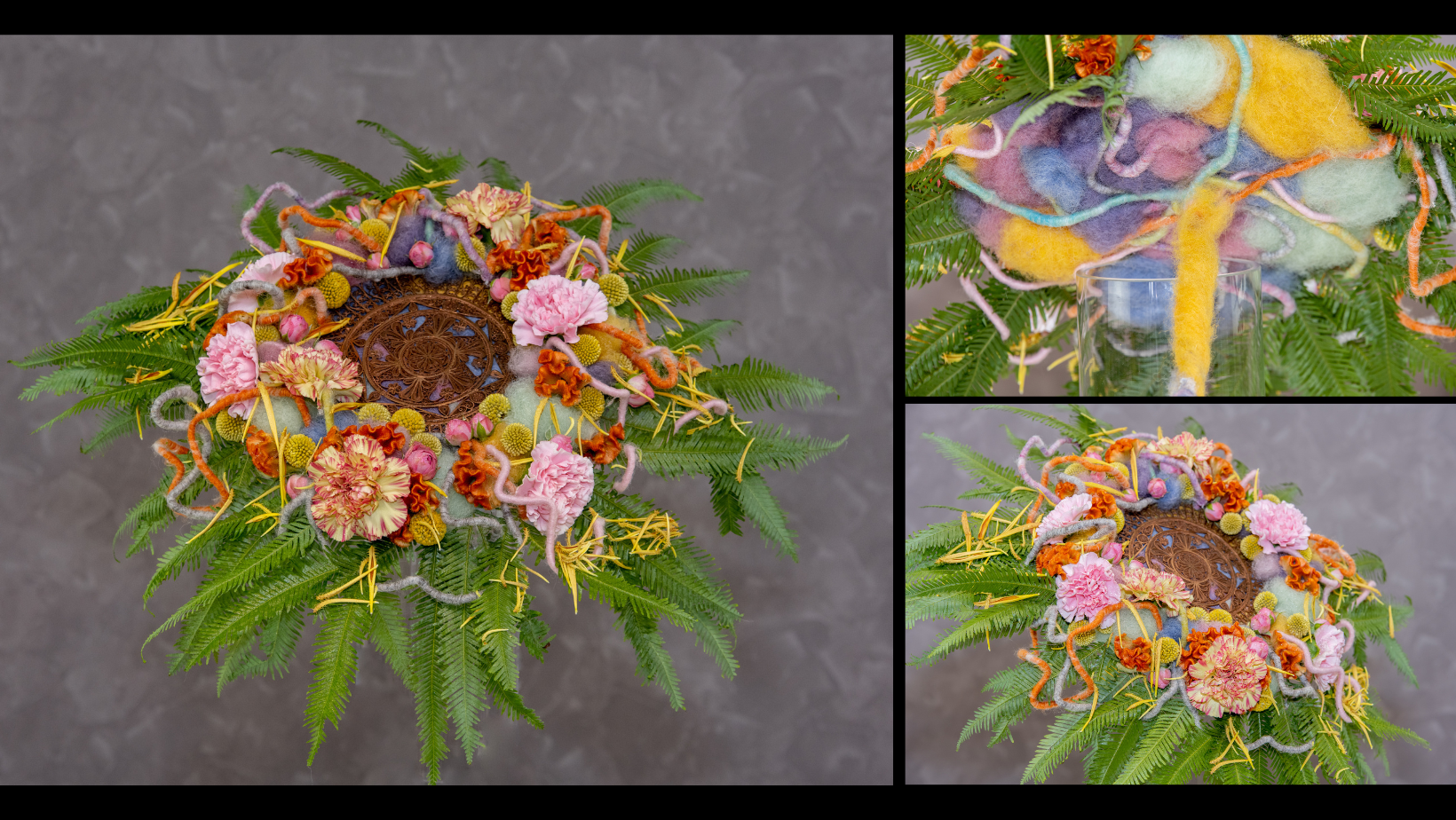
After laughing at Jorge’s comments, Fran went on to state that she wanted to create a contrast between the materials, especially with the feelings, visions, and sensation that you have with the wool. She wanted to play with the static and more traditional design, before creating transparency and movement, which she could enhance with the wool that had the wire running through it, giving even more movement and opposition, playing with the conscious, and this helped to get all the transparency into the design. She was so delighted to also be able to work with the beautiful Vanda orchids. For her, that was really amazing, just like being in heaven, to be able to work with both the wool and the Vandas. It was really an honour and a privilege to be there. Dina felt that she had created a really cool design.
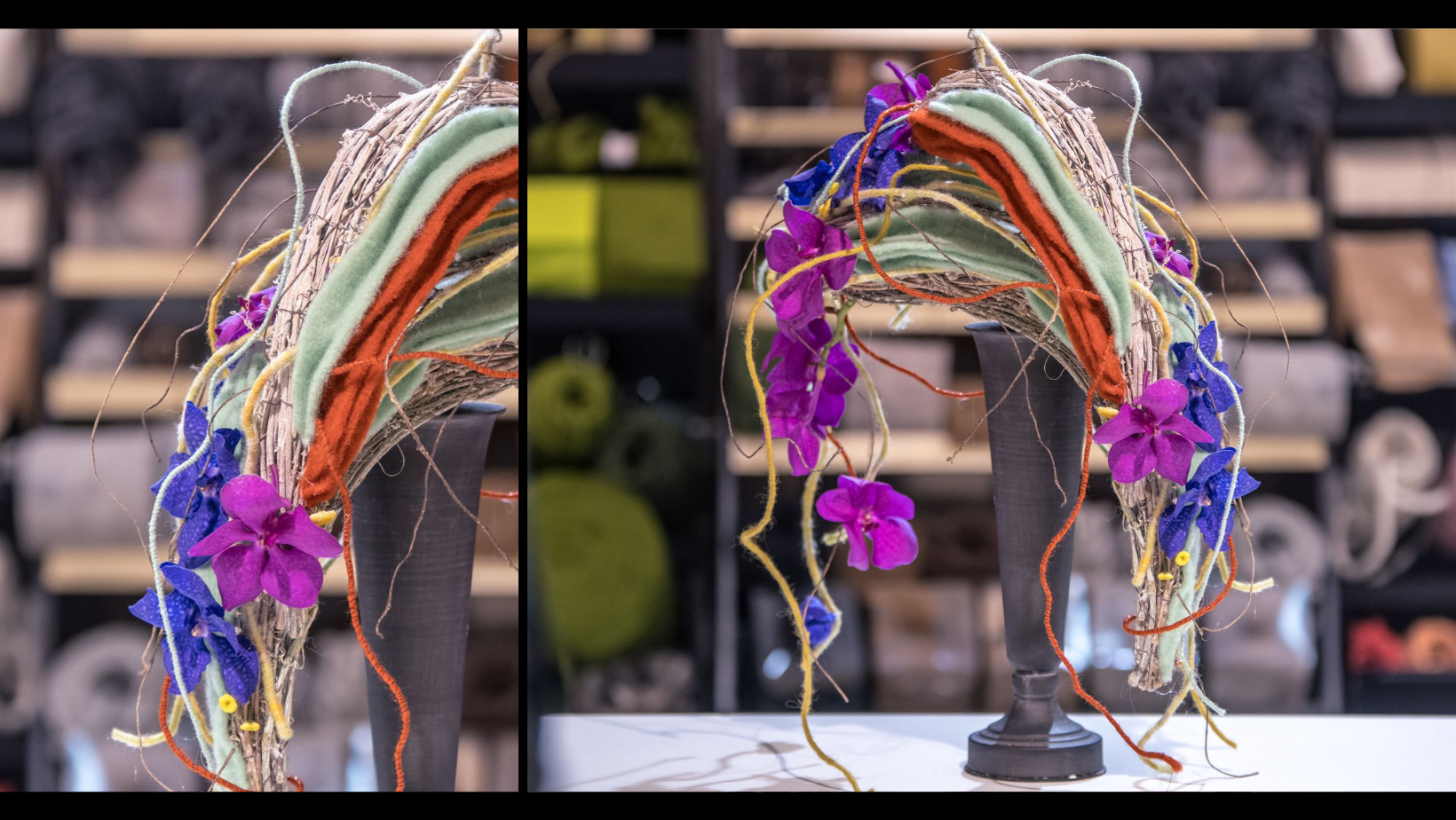
Diana also designed in the same room as Fran, working with the wool with the wire running through it too, integrating it with the other types of wool as well. She really wanted to play with the colours too. To be honest, she really wanted to play with the colours as the inspiration was not just the materials themselves but also working with the trends, which will be a topic for another discussion. She was working to a set colour scheme, wanting to also incorporate the metal piece that she had brought from home. It was a cool object of the type you find in a flea market, which has beautiful ‘embroidery’ within the dark colour. She wanted to work with background colours behind it and connect it to the other materials. The colours of the Dianthus were matching the colour scheme, but they were very heavy. It was really cool to be able to glue them onto the wool as it is a very sturdy material. It was very inspirational to be able to go to the colours that she wanted, the textures were really good; and it was a really great experience. Fran and Jorge both said that they wanted to ‘eat’ the bouquet because it reminded them of beautiful food! Diana said that it was just another example of the Willie Wonka factor!
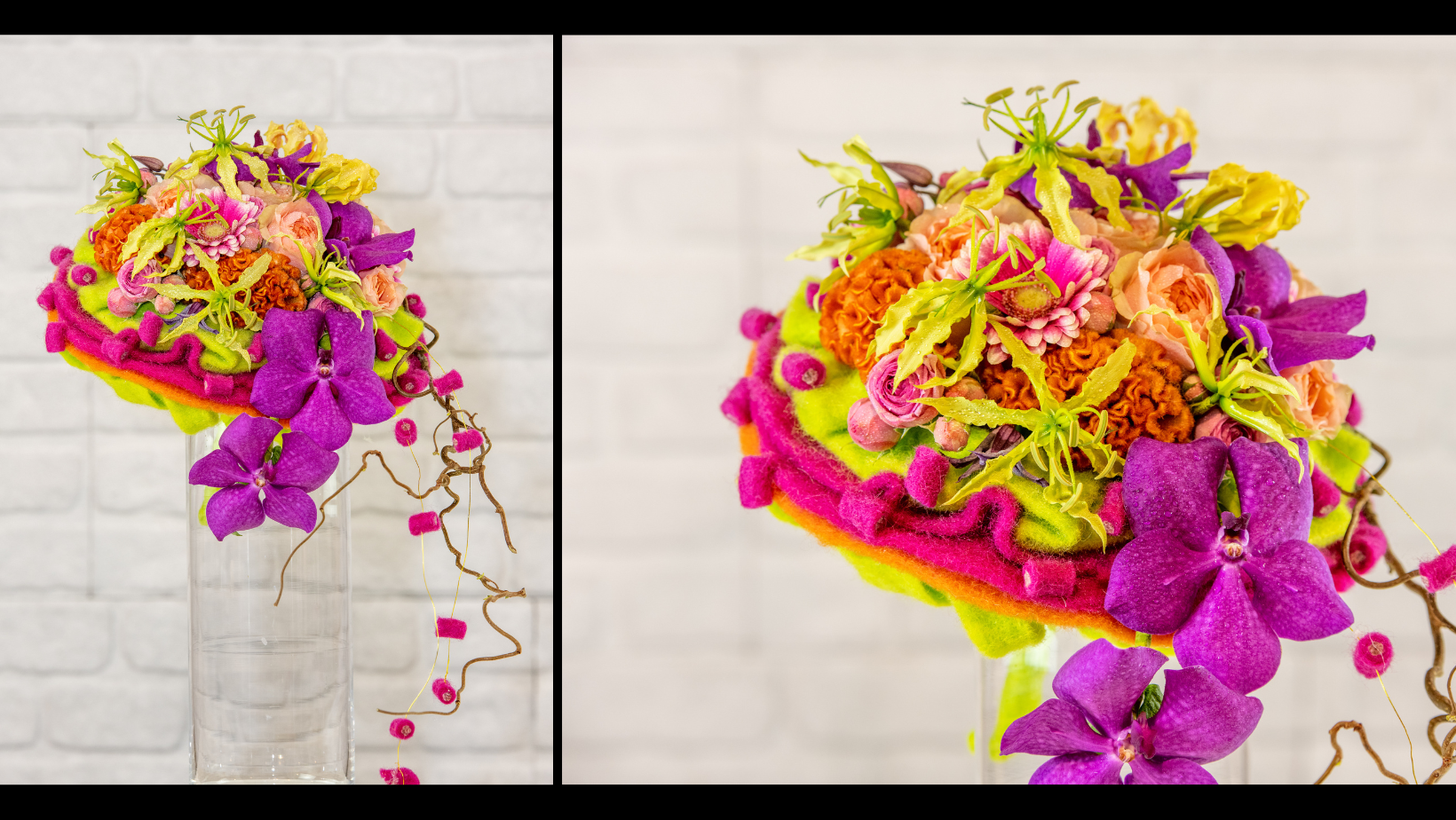
Don't miss a beat!
New blogs, course offerings and what we are up to delivered to your inbox!
We hate SPAM. We will never sell your information, for any reason.

